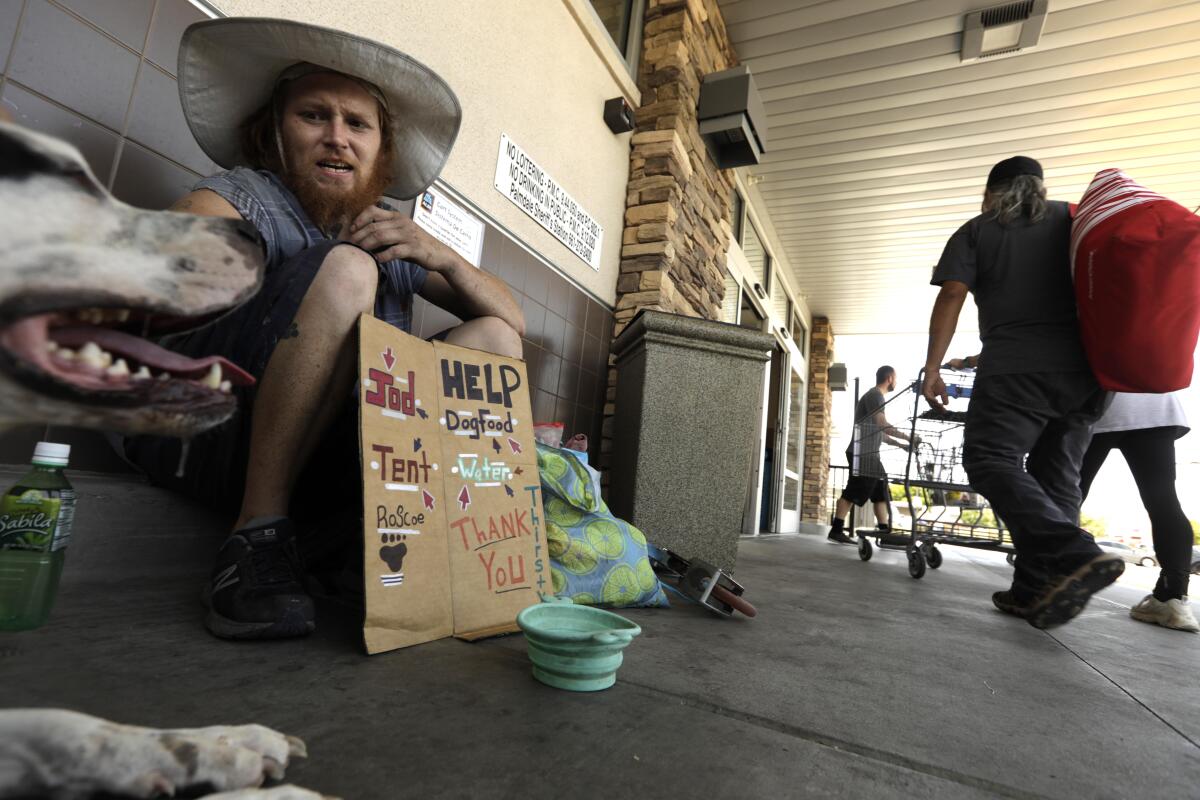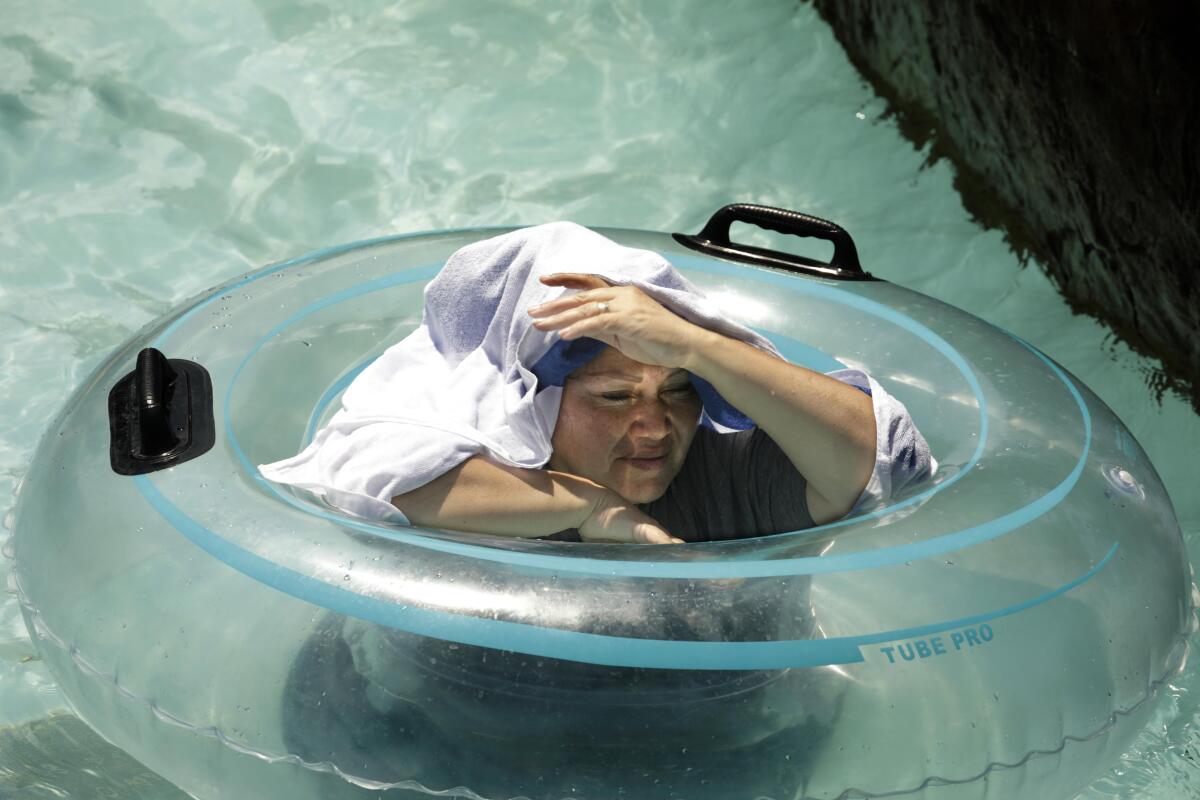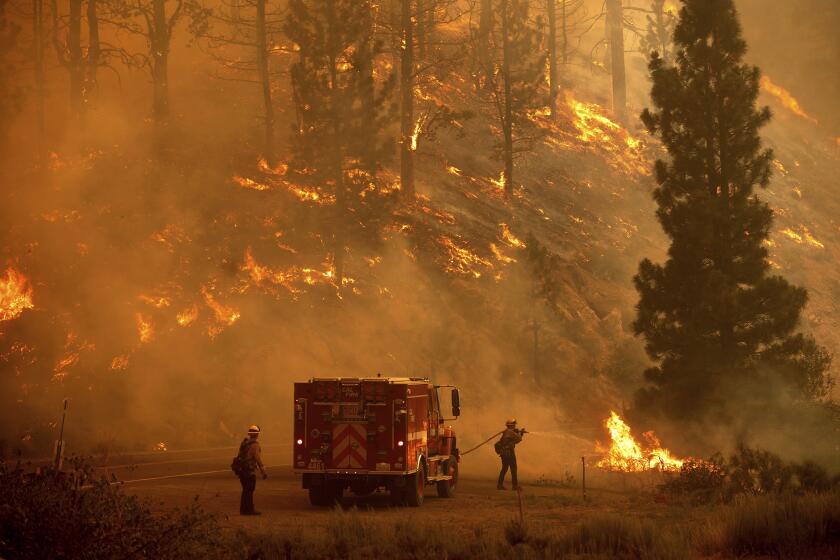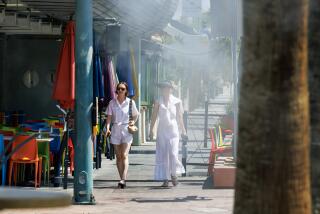‘It feels like it’s 100 every single day’: Worsening heat alters life for inland California

Anthony Wainscott has known his share of hardship, living the last two years on the streets of the Antelope Valley. But his personal misery index reached a new plateau during a weekend of record-setting heat.
“It’s extra hot. It’s abnormally hot,” said Wainscott, crouched in the meager shade of a palm tree on the edge of a shopping center parking lot Sunday in Palmdale, where the temperature hit 107 degrees. “I don’t even know how to explain it. But there’s something extra playing with the environment right now. And it’s not good.”
The 33-year-old Massachusetts native accepted the occasional donation from drivers, who briefly rolled down their windows to offer some change or a dollar or two. He used a dwindling supply of bottled water to fill a dish for his panting pit bull, Roscoe.
A few businesses would let Wainscott and Roscoe in for a few minutes to cool down, but he found many people’s patience wearing thin, so he spent most of the unbearable day outdoors.
“Nighttime is the only break we get,” he said. “And even then it’s way too hot.”
Like many other California cities, Palmdale saw record temperatures on Saturday — reaching 112 degrees, surpassing the previous daily high of 109 in 2003, according to preliminary figures from the National Weather Service.
Palm Springs saw a high of 111 degrees on Sunday, but that was down from Saturday’s peak of 120, which broke the previous record for July 10. Also on Sunday, the temperature hit 110 in Lancaster, 101 in Acton and 91 in Riverside. Though coastal areas remained in the 70s and 80s, humidity levels throughout the region brought their own discomfort.
Forecasters attributed the heat wave to an exceptionally large, exceptionally strong area of high pressure hovering over the California-Nevada border that sent temperatures 10 to 15 degrees above normal.

Although such events are fairly typical for this time of year, scientists say they are becoming more frequent and intense as global temperatures rise due to human-caused climate change.
“One hundred twenty degrees in Palm Springs, that’s not normal,” said Ivory Small, a meteorologist with the National Weather Service in San Diego. “So you can tell there’s a big high [pressure system] out there.”
The Eastern Sierra city of Bishop on Saturday recorded its hottest temperature ever, 111 degrees, breaking the record of 110 set in 2002. So did Barstow-Daggett Airport in San Bernardino County, although its high of 118 was previously measured twice before, in 1994 and 2007.
Palm Springs reached 120 and Borrego hit 117, topping the respective records of 119 and 116 set on July 10, 2012. Lancaster hit 113, breaking the daily record of 112 set in 1961; Merced Regional Airport reached 111 degrees, breaking the 1961 record of 108; and Needles reached 122, breaking the 2003 record of 121.
Daily records were tied in Paso Robles, Hanford, Sandberg and South Lake Tahoe, which hit 114, 112, 98 and 93 degrees, respectively.
Sunday was shaping up to be hotter in some areas, with even lifelong residents of the high desert saying the heat seemed abnormal.
Jody Clark, 52, had to take his mother to urgent care when her blood pressure dipped to a dangerous low. She was convinced that the high temperatures were throwing her body off, even inside her air-conditioned home.
“This is as hot as it’s been in a long time,” said Clark, who has lived in the Antelope Valley his entire life. “Now it feels like it’s 100 every single day.”
He’s thinking of moving his mother out of the area, partly to beat the heat. To Texas.
Temperatures of 110 or higher sent huge crowds to pools and water parks. Signs were up by midday declaring the DryTown Water Park in Palmdale sold out for the day. The city-run facility provided a refuge for about 1,500 people over the course of the day.
Visiting DryTown with an extended family group, Marcus Guerrero said he has heard that the temperatures were supposed to be more bearable because of the low humidity.
“People complain about the humidity, but I would take that over this,” said Guerrero, a singer and trumpet player in a mariachi band. “The winters seem to get shorter and shorter and the summers hotter and hotter.”

But Sunday’s conditions were actually more humid than normal because of monsoonal moisture working its way up from the Gulf of California, said Kathy Hoxsie, a meteorologist with the National Weather Service in Oxnard. That allows for less overnight cooling and makes it feel more oppressive, she said.
“What people are probably feeling is not just a little warmer but a little muggy,” she said.
Here, residents tend to feel the humidity once it tops 35%, as it had done in many areas by Sunday afternoon, or even 20% in desert areas.
Still, the conditions were nothing like what people experience in other parts of the country, where the humidity can easily reach 85% to 90% this time of year, Hoxsie said.
“Folks in the South and the East would pretty much laugh at us if we called it humid,” she said.
Although things were expected to start gradually cooling off Monday and Tuesday, the high-pressure system was slow-moving and so forecasters were calling for elevated temperatures to stick around for at least the next week and a half.
Jenni Parra, cooling off under an awning at the water park, said it feels as though the summer goes on without end.
“Now, I expect it to start getting hot by halfway through March. And then it stays hot all the way through … like October or November,” Parra said. “There’s no way you need a jacket, even at Thanksgiving.”
Parra, who grew up on California’s Central Coast, said the heat seemed to be affecting everything, even causing balky service on her cellphone. To her, there is no reasonable explanation other than climate change. She figures it would have been over 100 on past July days in the Antelope Valley, but she blamed the extra “six or seven degrees” on the warming planet.
“To me, it’s the big companies, like the power companies, that are not willing to do something about it,” said Parra, 31, a mother of five. “It’s time to change, to find renewable resources and actually develop them, even if they are not going to make the same profit. That’s the problem: They want the profit for themselves over the profit of all the people.”
The heat wave and a massive wildfire in southern Oregon that knocked out transmission lines combined to put a strain on California’s energy supply.
The California Independent System Operator, which runs the electrical grid for most of the state, said it was calling for power plants to delay any planned maintenance due to a projected increase in demand Monday and warned residents they might be asked to conserve power in an attempt to avoid outages.
In a bid to free up additional energy capacity, Gov. Gavin Newsom on Saturday signed an executive order allowing the emergency use of auxiliary ship engines to relieve pressure on the state’s electric grid, according to a statement.
Authorities received reports of homes destroyed in multiple communities, but no official figures have been released, said Lisa Cox, public information officer for the Beckwourth Complex fire.
In Northern California, the extreme heat, combined with an uptick in afternoon winds, was complicating efforts to control a wildfire that had already grown into the state’s largest of the season so far.
Authorities received reports that the Sugar fire had destroyed homes in multiple communities, but no official figures have been released, said Lisa Cox, a public information officer.
The fire, which ignited July 2, had spread to 83,256 acres as of Sunday morning and remained at 8% contained. It was one of two sparked by lightning in the Plumas National Forest that have together been dubbed the Beckwourth Complex. The other, the Dotta fire, started June 30 and was 670 acres and 99% contained by early Sunday.
Despite firefighters’ best efforts, the Sugar fire grew by more than 22,000 acres from Saturday into Sunday as it continued to behave erratically, at one point forming a fire whirl as it backed down an escarpment near the southern end of Constantia Road, Cox said.
“It’s really taken off,” she said. “I have to look at the numbers again because my eyes, it’s a lot to take in.”
Firefighters were being instructed to take frequent breaks and hydrate as an excessive heat warning from the National Weather Service was extended through Tuesday.
Fire officials have said that rising temperatures and drought have combined to wring moisture from vegetation, leading to environments that more closely resemble the peak of the fire season than mid-July.
“Right now we’re like two months ahead of schedule,” Cox said. “So we’re seeing fire behavior that normally happens in September.”
More to Read
Sign up for Essential California
The most important California stories and recommendations in your inbox every morning.
You may occasionally receive promotional content from the Los Angeles Times.













